Seoul Fashion Week wrapped up last Sunday and the single, lasting rejoinder of the international press seems to be, “that’s pretty good, for Korea“. It wasn’t Milan, New York or even Tokyo, but then no one expected it to be.
The Korean Herald put it far less kindly, calling it the worst fashion week in years, faulting its disorganization, lack of professionalism and pandering to international press–all claims I can not refute, particularly the last one (and I can’t honestly say that I minded). For others here, Seoul Fashion Week was “kind of blah”.
But as runway photographer–part of the pandered-to, international VIP contingent–I saw things differently, if not to say, better (no matter how predictable such an outcome may be when you are plied, night after night, with Moet). Even so, we were not so besotted as to find no fault(s) at all:
Oh, the venues are so wretched, so drab, so 1980s, so far away, so so so so…is there no place to get a drink around here?
And it’s true, SETEC is imposing, ugly-like-a-nuclear-power-plant, and lacking in any design element whatsoever–unless you consider it ‘design’ to place three large, white, windowless cubes in the middle of a brown, arid field at the farthest outer reaches of Seoul — almost far away enough that one could forget its scarring presence on the cityscape, its white exterior nearly blending into the smog-filled skies.
Verdict: SETEC is no showcase for fashion…a similar conclusion as that reached by reporter and art critic Ana Finel Honigman.
And then there were the other venues — like Daily Projects (profiled by Maisie Wilhelm at soon-to-revolutionize-your-closet, pre-launch Stylecaster), Space Gallery, KOEX — showcases for Next Generation Designers like Tae Yong Ko, Paul&Alice and Kiim, to name only a few. International reporters were enamored by these spaces. They gave East Village like whiffs of the underground, emerging artist scene that remains, in the US and Western Europe, the much romanticized alternative to the homogeneity of big label, big production anything.
Here, however, there was squandered potential: “Emerging” need not mean that you don’t take care with the lighting. “Emerging” need not mean that you lay down a runway in front of an enormous, menacing, aesthetics-destroying black ventilation pipe.
A criticism almost too trite to mention, however, will not go unsaid: the models are quite simply too skinny. They most certainly look starved. It is difficult to impress internationals, and presumably that was a primary agenda for the week, by trotting before them colorful, well-tailored garments hung loosely on the skeletons of barely-nourished, one-step-from-the-feeding-tube, hollowed-cheek, North Korea famine survivors. They are skinnier than Madrid. Please, feed them.
And then there was the twenty minute video following the runway show at Daily Projects. This wasn’t a video for those who missed the show — it was projected in the same room as the show and seemed to request audience attention AFTER the last model went down the runway. Intended as multimedia enhancement to the entire production, most of the audience felt first bewildered, then mocked (for why would we still sit there and watch this digital crap when a great LIVE show just happened before our very eyes), and then they left, most within five minutes, none staying the entire length of the film. It was a lousy finale to an otherwise interesting and even commendable show.
My advice: Paint pipes white, work on lighting, feed your models, work on endings — all little things that would provide relatively large payouts.
Now, finally, you may be asking, what about the designers themselves?! Well, I’ll just discuss three designers here – but links to all photos are below:
Woo Young Mi produced an exceptional show with imaginative designs.
Though, Woo seems to have the impression that men like to wear jackets on their head…
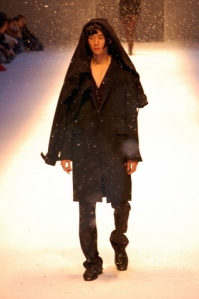
Jackets as Hats
And most of Woo Young Mi’s pieces are just downright kinky. Redolent of militarism and molestation–it’s Mussolini goes to Neverland: transparent plastic jackets, trousers and hats, double-brested wool coats, glossy, white Michael Jackson ski pants).
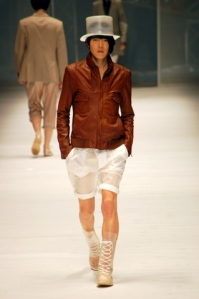
Mussolini goes to Neverland
Finally, for Saturday’s Seoul Fashion Week Finale, there was Gee Choon Hee. I was not familiar with this “known” star on the Seoul fashion circuit, though I had been prepared for an “upper east side”, Caroline Herrera look. But let me tell you, Caroline Herrera looks like Body of Evidence type of stuff compared to the cutesy, frilly, Pearl Harbor-waiting-for-your-man swirling of super models put on by Gee Choon Hee.
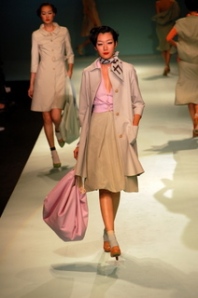
Pearl-Harbor-Waiting-For-Your-Man
Finally, Yoon Ki Suk, has a mens lineup that really does make me want to dash off to Gangdam right now and buy everything at his LOTOCO flagship store. Oversized, brass-studded leather bags are juxtaposed against the frailty of gossamer fabrics, or nothing at all. Manly man meets delicate feminity in a yin/yang theme that is surprisingly fresh. At last, I can wear mesh and feel like a man.
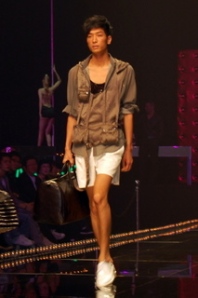
Manly Man Meets Delicate Feminitiy
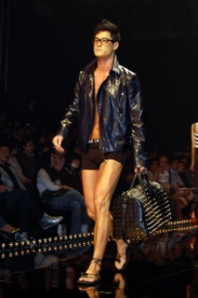
A covetous bag, indeed
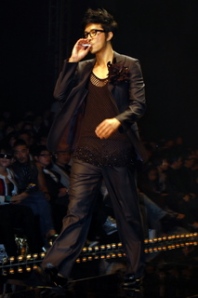
Manly in Mesh
For more photos from Seoul Fashion week:
Woo Young Mi (Solid Homme)
Gee Choon Hee
Yoon Ki Suk (Lotoco)
Daily Projects (Next Generation Designers)
Gallery The Space (Tae Yong Ko)
Kang Dong Joon (D.GNAK)
Ha Sang Beg
Yang Hee Deuk












